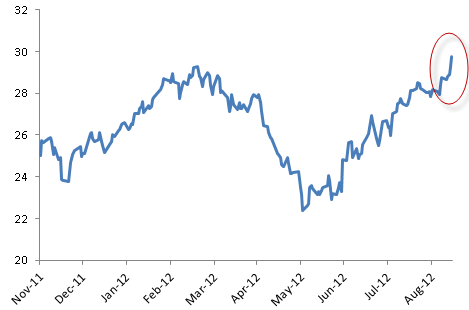One of the most frustrating byproducts of the financial crisis for investors and portfolio managers is the so-called Risk on, risk off phenomenon. Yet there are signs we may finally be moving back to a more “normal” market as the Federal Reserve winds down its stimulus program.
“Risk on, risk off” is a pattern in which commodities, stocks, currencies and bonds “move very tightly in predictable ways and which has been the dominant trade in the post-financial-crisis landscape,” according to Reuters.
In financial-speak, this means that correlations have been very high in the wake of the credit crisis. Correlation measures the tendency of securities or asset classes to move together.
During risk-off bouts in recent years, riskier assets like stocks would fall, and investors would buy traditional safe havens such as U.S. Treasury bonds and the Japanese yen, for example.
‘A surprising and hopeful story’
Why are high correlations a bad thing for portfolio managers and investors?
For portfolio managers, it makes it harder to outperform the market through stock-picking when everything is moving together.
And for investors, higher correlations make it more difficult to diversify. The whole point of diversification is to reduce risk by spreading money around into several different asset classes. It doesn’t work as well when they’re moving in unison.
However, there are signs that individual asset classes and stocks are starting to go their own way, rather than running as a pack.
“Our monthly look at the price action for a range of asset classes and industry groups tells a surprising – and hopeful – story. Correlations have fallen to new post-financial crisis lows,” ConvergEx Group analysts said in a note Thursday.
Here are some of the highlights:
- The average 30-day historical correlation of the 10 industry sectors in the S&P 500 to the index as a whole is down to 68.7%, lower than last month (70.6%), the old lows (August 2013 at 69.9%), and far from the highs (+95% through parts of 2011).
- Currency correlations to U.S. stocks are near zero in the case of the Aussie dollar and euro, but still relatively high (40%) for the yen.
- Foreign stocks were similarly disconnected from domestic equities last month – down to 46% correlation to U.S. stocks, from 83% last month, and Emerging Markets at 36% from 46% last month.
Back to the fundamentals
Falling correlations are good news for active managers whose mission is to generate excess returns or “alpha” by picking winning stocks and sectors.
“We’ve had years of ‘Risk on, risk off’ market swings where everything seemed to rise and fall like rubber duckies in a kid’s bathtub,” ConvergEx said. “Are markets finally back to pricing assets based on fundamentals rather than gaming the next round of central bank monetary policy?”
In the U.S., this week’s release of the minutes of the latest Federal Reserve meeting showed the central bank may end its quantitative easing or QE program in October. The Fed has been buying huge amounts of bonds in an effort to keep interest rates low and stimulate the economy after the financial crisis.
The latest correlation data show “we can put a wooden stake in the heart of ‘Risk on, risk off’ and officially declare that blood (and soul)-sucking market theme dead and buried,” according to CovergEx.
Still ‘suspicious’
Yet interestingly, the analysts note that falling correlations are not necessarily a bullish sign for the market.
“The best thing you can say is that owners of capital should be reassured by this price action, since lower correlations allow for better diversification … But after more than half a decade of turmoil and living with ‘Risk on, risk off’ it is easy to be suspicious,” they wrote.
“If correlations can remain low, it will show that investors are not relying on the Federal Reserve to bail them out again. And that will be something worth celebrating, regardless of where the S&P 500 happens to close,” the analysts concluded.
Try Covestor’s services with a free trial account. Or you can contact our Client Advisers at 1.866.825.3005.
DISCLAIMER: The information in this material is not intended to be personalized financial advice and should not be solely relied on for making financial decisions. Past performance is no guarantee of future results.





